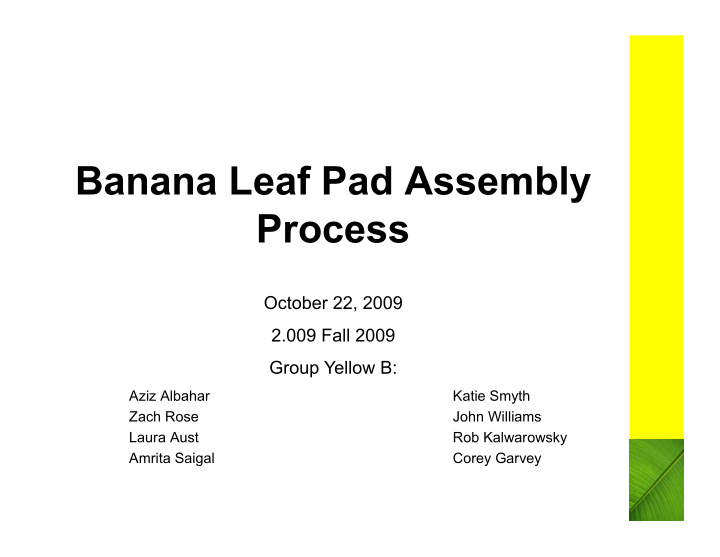



Banana Leaf Pad Assembly Process October 22, 2009 2.009 Fall 2009 Group Yellow B: Aziz Albahar Katie Smyth Zach Rose John Williams Laura Aust Rob Kalwarowsky Amrita Saigal Corey Garvey
Concept • Women in Rwanda lack affordable feminine pads • Low volume, low cost, low tech • Designing production sub-processes: Portioning Shaping Layering Crimping Cutting
Contract Product Description: Assembly machine for making banana leaf pads Intended Customers: Women in Rwanda Market: Developing World Customer Need Product Attribute(s) Engineering Specification(s) Improve production rate Rate Minimum: > 5 pads per minute Machinery can work Power Less than 40W within African infrastructure Easy to repair/ Number of parts, Less than 50 parts, simple troubleshoot robustness Reduced labor cost Automatic, ease Less than 4 operators, steps must easy to do Pads cost too much Cost Produce 10 pads for less than $1.10
Decision-Making Process Roller with Separate Compressed Extrusion Die Hand Portioning None Pocket when wet Air Stamping – Stamping – Vertical Pouring Shaping None Rollers Pocket Rollers Press (slurry) Sheet Rollers Folding Layering None Stamping Crimping None Pressure Cutting Vertical Blade Die Heat Laser Hot Wire None
Significant Risks: Portioning and Shaping • Identified major risks through discussion and group vote Portioning Shaping Layering Crimping Cutting
Batch Solution: Pad Die • Polyethylene and banana fiber layered on cavity • Die core pushes and separates pads into pockets • Polyethylene stretching approximation: yields inaccurate results Finite Element Approximation: Polyethylene Sheet • Displacements similar to pocket depth • Stress does not exceed material yield
Continuous Solution: Extruder Portioning • Processed banana fiber inserted into chute • Timing of linear actuator portions out pads onto polyethylene sheet Polyethylene Electric Solenoid Sheet Linear Actuator Friction Rollers • sand paper provides friction • total applied force: • Limitation – short stroke length (~1”)
Continuous Solution: Cylinder • Roller cylinder with cavity that is filled with fiber • Metal “scraper” to brush off excess • Continuous process, hand crank operated • Can be used as initial step
Findings • Conclusions : individually each machine does not address portioning and shaping adequately – Best to combine concepts based on strengths
Questions?
Recommend
More recommend